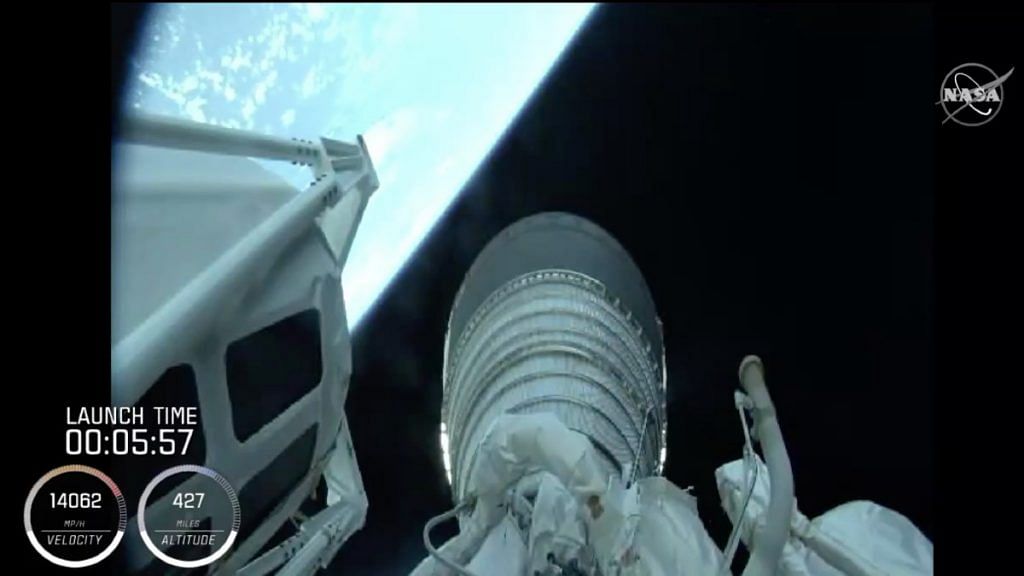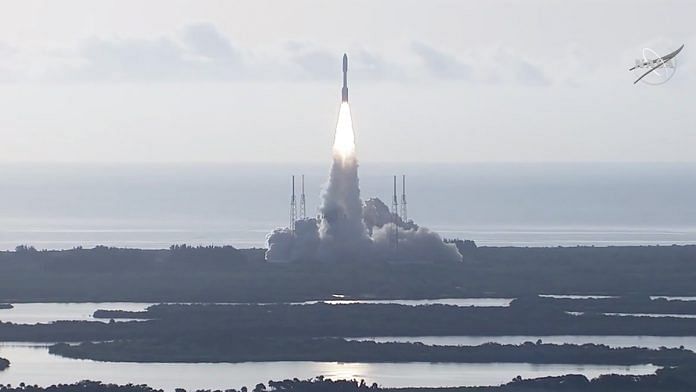Bengaluru: The most sophisticated and complex Mars mission has just departed Earth for the neighbouring planet.
The NASA mission, called Mars 2020, consists of a rover and helicopter and was launched from Cape Canaveral in Florida, at 5.20 pm Thursday, atop the rocket Atlas V-541.
The spacecraft will reach Mars in February next year and the Perseverance rover is expected to touch down in the Jezero Crater on 18 February 2021. The accompanying Ingenuity helicopter will be the first helicopter or a flying robot to go to another planet. The mission does not have an orbiter.
The objectives of the mission focus on astrobiology and finding evidence of past or present life on the planet. The rover will also collect and store a cache of soil and rock samples from the surface of Mars for a future sample return mission.
Perseverance is based on the design of the highly successful Curiosity rover, which is still actively exploring the Red Planet. The rover is expected to function for at least one Martian year or 687 Earth days.

Also read: Mars may have had rings like Saturn years ago, and they could form again
Mission profile and objectives
NASA is the only space agency to have landed a craft successfully on Mars, but landing an expensive, speeding spacecraft on the planet will still be a monumental task. The entry, descent and landing system (EDLS) will be similar to the Curiosity rover’s famous ‘seven minutes of terror‘, the time it took for the spacecraft to land on Mars surface after entering the planet’s atmosphere.
The rover will slow down using reverse thrusters, descend using a parachute, and bounce on the rocky surface cocooned in protective balloon-bags. The spacecraft will also steer itself during landing towards a flat, safe surface.
Perseverance weighs 1,025 kg — with six durable aluminium wheels and a five-jointed robotic arm. The craft runs on solar power but also has a backup generator running on plutonium to power itself through Mars’ notorious sand storms that can cover the entire planet and block out the sun for days.
? We have LIFTOFF to Mars! The @ulalaunch Atlas V takes flight with our @NASAPersevere rover. The #CountdownToMars continues as Perseverance begins her 7-month journey to the Red Planet! pic.twitter.com/3RTL1CR4WS
— NASA (@NASA) July 30, 2020
It has seven scientific payloads, 19 cameras, and two microphones, which will record sounds from Mars for the first time ever. The payloads include spectrometers to study the surface composition, radar imagers to penetrate the ground and detect underground water, sensors to record environmental conditions, and an oxygen generating experimental payload.
Two of these payloads — the Scanning Habitable Environments with Raman & Luminescence for Organics & Chemicals (SHERLOC) instrument, which can detect organic matter, and the Planetary Instrument for X-ray Lithochemistry (PIXL), which measures the composition of rocks and soil — will enable mapping of organic matter, chemical composition and texture at a greater level of detail than any Mars mission before, and will play an important role in looking for biosignatures.
The lander also has a Terrain-Relative Navigation system on board, that will help the rover move, and this will be the trial version of the navigation system expected to help future robotic and crewed exploration of Mars.
The rover will also investigate surface geology, geological processes and history in an attempt to map out the evolution of Martian surface features and its water.
The Ingenuity helicopter is autonomous and will function independently of the Perseverance. It is a tech demonstrator — built to test the ability to fly in the thin Martian atmosphere. It weighs 1.8 kg, is solar-powered and carries two cameras. It is less than half a metre high and has a rotary wingspan of 1.2 m.
Ingenuity will fly a total of five times, climbing up to a height of 10 m for a maximum of 3 minutes during each flight.
Search for life on Mars
The Jezero crater, which is a large landing site on Mars, is believed to be most likely to harbour life, if at all.
This 49 km-wide structure was a 250 m deep lake that held liquid water about 3.5 billion years ago. Even today, it consists of rich clay deposits and shows evidence of river deltas carved by the continuous flow of surface water.
The presence of water is thought to be a good indicator of habitability on extra-terrestrial bodies because water is necessary for life on Earth. It is an effective solvent, disperses minerals and nutrients efficiently, maintains optimal thermal conditions and facilitates organic biochemical reactions.
The rover will collect and store 31 samples of rock cores and surface soil to bring back to Earth later in a future mission.
The Mars 2020 mission joins two other missions heading towards the Red Planet in this 2020 launch window: The United Arab Emirates’ Hope mission, its first mission beyond the Earth’s orbit that was launched 10 days before Mars 2020 on 20 July. It consists of an orbiter that will study the planet’s gases as well.
China, too, launched its mission called the Tianwen-1 on 23 July, which consists of an orbiter and a rover. If successful, this will also be China’s first mission to reach Mars.
All three missions will reach Mars in February, and all three intend to look for signs of present or past life on the planet.
Also read: Marsquakes and strange magnetic pulses — what NASA’s Mars mission has unveiled so far




Excellent